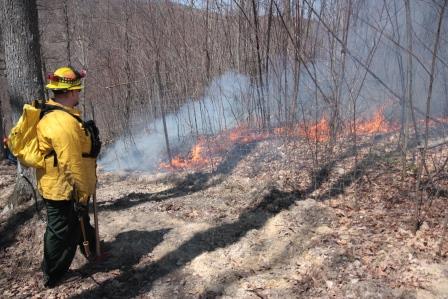
EMPORIUM – Prescribed fire is a management tool involving the use of fire to manage vegetation. Prescribed fire is not a new concept, according to Jeanne Wambaugh, district forester with the Elk State Forest.
According to her, Native American’s were documented using fire to alter the habitat for the following reasons: clear trails, herd wildlife, clear farmland, maintain grasslands for game, encourage berry production and to find chestnuts. Today, she said fire is still a valuable tool when a Prescribed Fire Plan is well written and followed.
A Prescribed Fire Plan, she said, is a site specific document which includes 24 detailed items: location, fire area, maps, justification, resources, organizational chart, fuel and weather considerations, etc. This document, she said, must be sent to both the Department of Environmental Protection and the Department of Conservation and Natural Resources for review.
According to Wambaugh, there are four prescribed fire program goals: provide for firefighter and public safety as the first priority; ensure that risk management is incorporated into all prescribed fire activities; use prescribed fire in a safe, carefully planned manner and utilize prescribed fire to achieve specific fire and natural resource management objectives.
Although prescribed fires were done in the past, Wambaugh said it wasn’t until 2009 that prescribed fire in Pennsylvania was authorized by the Pennsylvania Prescribed Burning Practices Act (Act 17 of 2009). All prescribed fires conducted in Pennsylvania, Wambaugh said, must be performed in accordance with this act and these standards.
This guide, she said, was developed by the Pennsylvania Bureau of Forestry and the Pennsylvania Prescribed Fire Council, Training and Standards Committee. For more information visit: www.paprescribedfire.org
“With this management tool available to both public and private land owners, you may see an increase in prescribed fire use to manage vegetation,” said Wambaugh. “Whether it is to reduce vegetation to prevent forest fires, create better forage for wildlife or to reduce mountain laurel to regenerate a forest, prescribed fire is important and beneficial.”
The first prescribed fire of 2014 was 26 acres in Benezette Township, Elk County. It was carried out on Thursday. It is within a within 55-acre fenced treatment area. The goal of this burn was to reduce the fuel load, control competing vegetation, release the oak regeneration, and staff training. It began at 10 a.m. and was completed at 4 p.m., said Wambaugh.


